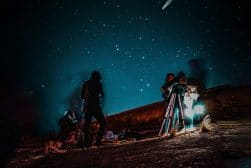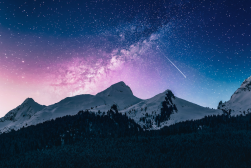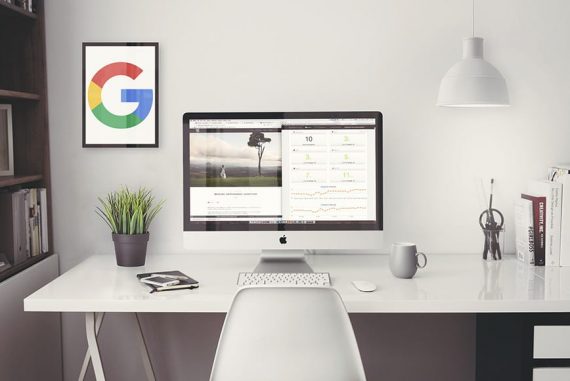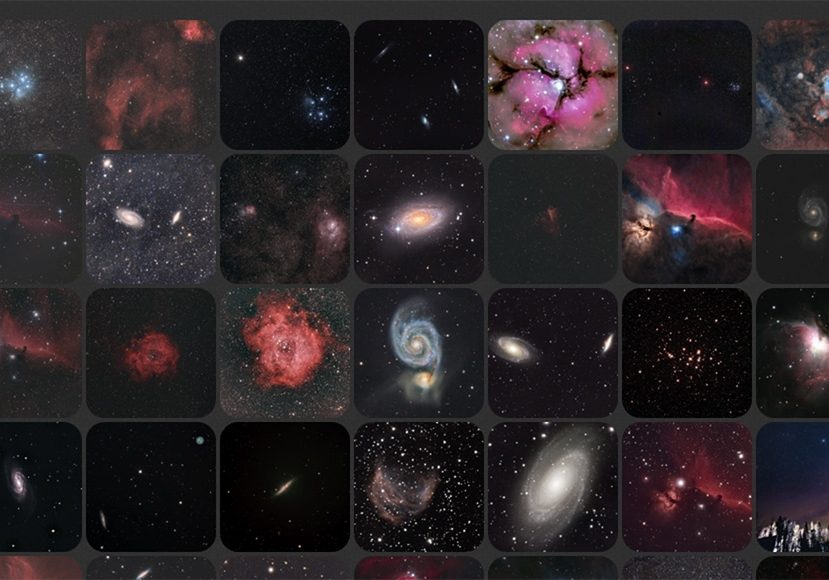
Astrobin Review – Image Hosting & Social Network for Astrophotographers
Fan of astrophotography? Take a tour of some breathtaking photos of our galaxy on Astrobin - a unique social network for astrophotographers that we review here.
Learn | Photography Guides | By Greg Cromie
Are you interested in doing astrophotography but don’t know where to start? Do you want to elevate your night sky photography to a scientific level?
Or, are you just sick of the lack of good support, groups and forums available for astrophotographers?
Read on to discover why Astrobin is an essential tool and resource for anyone interested in the astrophotography genre.
In this review, we’ll look at the Astrobin platform, what it has to offer, and address all of the most common questions.
Once upon a time, in a galaxy far, far away…
What is Astrobin?

- Dedicated astrophotography site
- Image hosting with data overlays
- Helpful forums and groups
- Comprehensive search function
- Free trial
- Affordable pricing structure
- Astrophotographer profiles and galleries
- Nothing we can think of!
Astrobin is an online platform that’s accessible from a desktop or mobile internet browser. Created in 2011, Astrobin is the best online resource and support for astrophotography.
Astrobin is by far the most accessible astrophotography image hosting platform around. Regardless of shooting with a DSLR, mirrorless camera, a backyard telescope or a deep-space observatory, Astrobin is the place to be.
AstroBin provides a comprehensive set of services tailored to the astrophotography genre. These include varying levels of subscriptions depending on the level of data and support required.
With a strong focus on data integrity and accuracy, AstroBin does more than provide a place to pin your photos.
It features data overlays of celestial bodies to accurately identify and label the night sky you’ve painstakingly photographed.
Plus, if you’re planning to capture a particular celestial object, you can perform a search to see the same part of the sky photographed by others.
That way, you can visualise what you’ll be looking at when you head out to set up your astrophotography shot.
Finally, AstroBin provides a safe and secure platform to host images, offer support with forums and groups, and provide connections with other astrophotographers.
AstroBin Explore
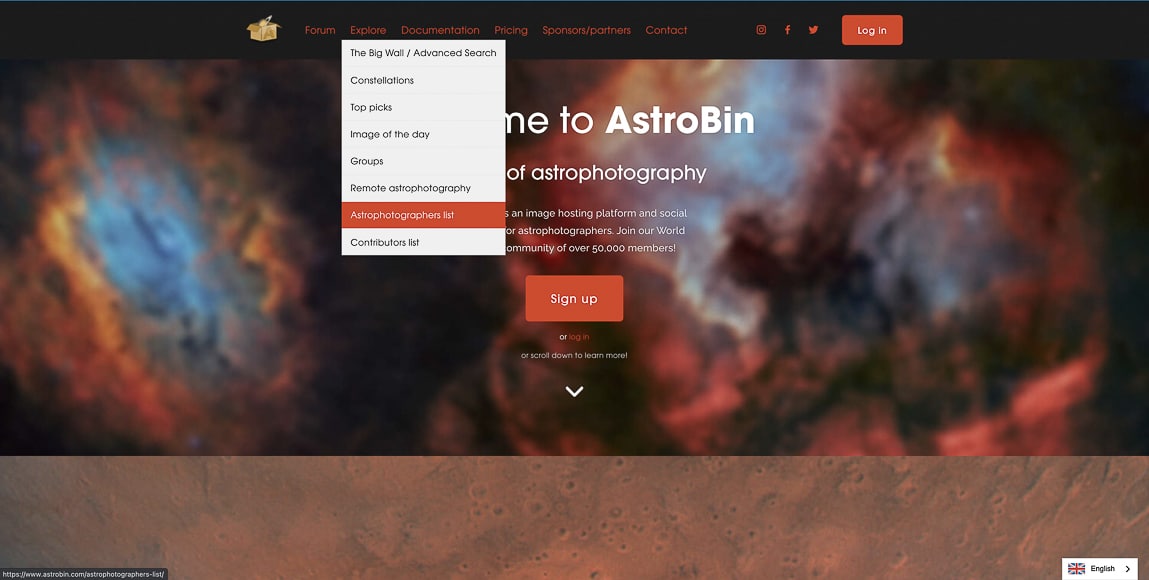
AstroBin features an Explore drop-down menu that provides users with several options to locate images and information. It’s the first place to check out on the site as it contains easy to use features.
Let’s explore (pardon the pun) the Explore menu in more detail.
Search
The first option in the Explore menu is The Big Wall, or Advanced Searched function, where you have access to view thousands of pages of astrophotography images.
Alternatively, type in search terms to locate anything relating to the desired content within AstroBin.
Search Filters are limited in the Free Trial and Lite versions of the subscription service. The higher-tier subscriptions provide more accurate search filters and outcomes.
Constellations

My favourite feature within the Explore menu is the Constellations search.
It provides a handy and easy to use catalogue of all the known constellations in alphabetical order. What’s more, there’s a short blurb about each constellation and a button to jump to any photos featuring that constellation.
Top Pick
Top Picks Nominations is a favourites gallery where the nominations for best photo are on display.
How Much Do You REALLY Know About Photography?! 🤔
Test your photography knowledge with this quick quiz!
See how much you really know about photography...

You can refine the list of nominated photos by selecting the style of gear used and the means to capture the image – backyard, remote, observatory, etc.
The Explore menu also has a Top Pick option to showcase the best photos for users to discover.
Image Of The Day
Image Of The Day provides a chosen daily astrophotography image – some of these are truly mindblowing.
Groups

Much like those found on sites like Reddit and Facebook, AstroBin includes a Groups section to support astrophotographers’ specific needs.
Groups are readily accessible to the whole community regardless of having a paid subscription or not. To participate in groups, you must register an account with AstroBin.
A simple example of an AstroBin group is Fujifilm Cameras – it’s a page for astrophotographers that shoot with Fujifilm cameras and lenses.
There’s another discussing Sony lenses for astrophotography and many other topics.
There are over 100 groups that cover everything from Schmidt-Cassegrain Telescope (SCT) Imagers to Supernova Imagers.
What’s more, it’s simple to create a group and build a gallery with like-minded photographers.
Remote Astrophotography
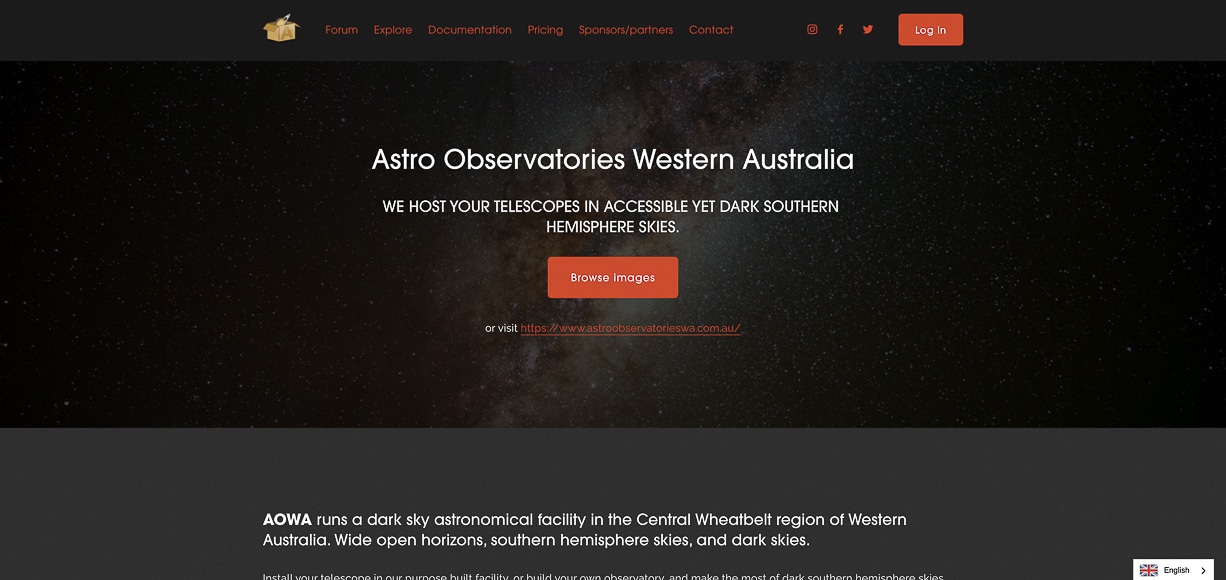
What if I told you that AstroBin provides users with the opportunity to access remote locations to view the constellations?
With the Remote Astrophotography menu, you can.
AstroBin has partnered with several highly acclaimed observation locations in Spain, Western Australia, Chile and New Mexico – to name a few of the global sites.
For example, the Astro Observations Western Australia (AOWA) operates an astronomy facility in Western Australia. The site grants access to wide-open horizons and dark skies in the Southern Hemisphere.
It also allows you to set up your remote telescope or even to build your observatory on location. You can visit the site or set up your remote observation point to access the southern skies without leaving the comfort of your own home.
Another option is ChileScope, where you can use their site to access astronomical data and even book one of their four telescopes for deep space observations. It’s astrophotography on-demand – how cool is that?!
What’s more, if you want to know what the night sky will look like from AOWA or ChileScope, click on the View Images button to see the AstroBin gallery.
Astrophotographers and Contributors Lists
The final two options in the Explore menu include the Astrophotographers List and the Contributors List.
The Astrophotographers List contains AstroBin profile links of the thousands of astrophotographers subscribed to the site.
The Contributors List ranks those who contribute their photos, participate in forums, and provide comments and feedback on others’ work.
AstroBin Forums

AstroBin is also popular within the astrophotography community thanks to its well-received and informative forums.
Anyone with an account can read and take part in forum topics and discussions.
With a genre like astrophotography, learning skills and acquiring knowledge from others is key to success. People can’t walk out into the desert with a camera and expect to capture stunning deep space images of the stars and solar systems.
It takes a lot of prep and knowledge learnt from those who have come before being good at astrophotography.
As with any community-based information service, AstroBin forums allow everyone to take part in the conversation.
Regardless of having a question, information to share, or wish to share your mistakes so that others might learn, forums are the way to go.
The forums page features clean and neat layouts. It’s split into four main categories to make locating the correct forum more accessible – each topic expands again into sub-topics and so on.
Astrophotography Technical Forums

Astrophotography Technical Forums covers the complex knowledge and skillsets involved with astrophotography.
- [Deep Sky] Acquisition techniques
- [Deep Sky] Processing techniques
- [Solar System] Acquisition techniques
- [Solar System] Processing techniques
- Equipment
- Electronically-Assisted Astronomy (EAA)
- Requests for constructive critique
The Off-Topic Forums

Most forum sites will host a section for off-topic or unrelated discussion among members.
If you talk shop with a group of like-minded people, chances are you have enough in common to discuss other topics too. This section splits into two forum categories.
- Introduce Yourself!
- Anything Goes
Language-Specific Forums
As AstroBin is an international platform for all astrophotographers, there’s a need to support languages other than English.
While stunning photos of deep space don’t need translating, gaining advice or participating in forums is tough when you don’t speak English.
Fortunately, the Language-Specific Forums accommodates this by providing categories in German, Italian, French, Spanish and Russian.
Group Forums
If you’ve joined or created a group within the Explore menu, you can participate in group forums.
Going back to our Fujifilm Cameras group, the participants can use the matching forum to discuss all things Fujifilm and astrophotography.
User Profile
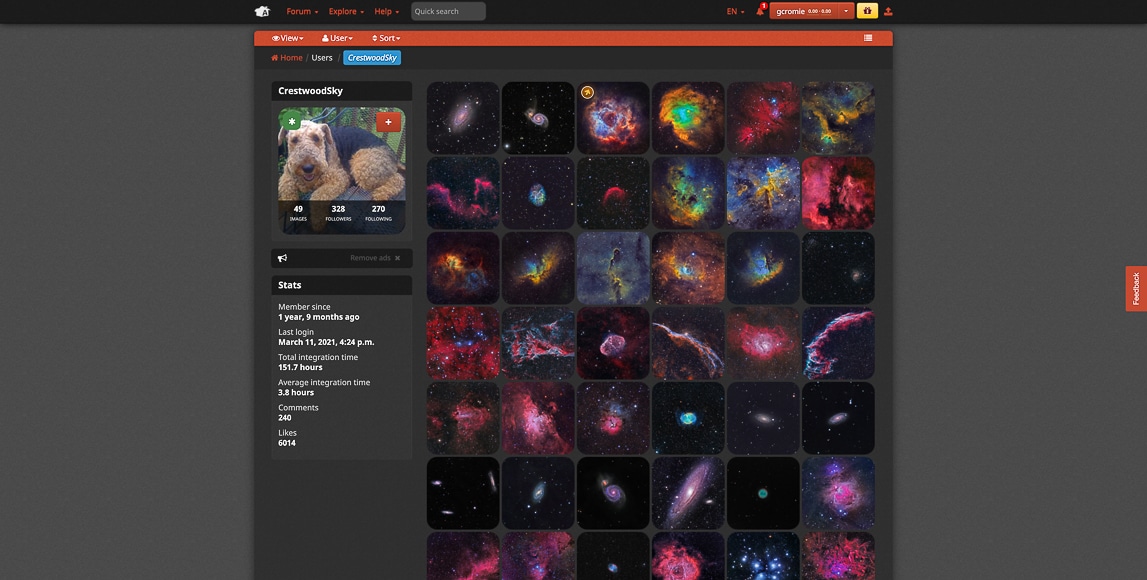
AstroBin allows users with a subscription to create their profile page that includes a bio and image gallery.
In this respect, AstroBin works just like any other social media platform.
The profile pic has a text overlay with likes, followers and following.
The page also hosts user stats, including how many Integration Hours and the Average Integration Hours logged. Plus, it shows how long they’ve been a member and how many images they have posted.
The rest of the page is the personal image gallery with thumbnails of each photo. When you hover your pointer over an image, social stats will appear to show the post’s date, how many likes, comments and bookmarks.
Clicking on any of the thumbnails will bring up an image page – let’s take a closer look at that next.
Image Page

When viewing an individual image from a gallery, search, or profile page, you can explore further to get more information.
Each image is hosted on a standardised template to provide comprehensive data on the photograph and shooting situation. The image page template has several different sections.
Image
The image takes up most of the page. It’s viewable in a frame, at full screen, or even at the full resolution of the original capture. Keep in mind that depending on the subscription level, image files can be 50MB and higher.
If you hover your pointer over the image, a data overlay appears that circles and labels each of the central celestial bodies. You can also view it as an inverted monochrome image to identify celestial bodies quickly.
Technical Card
The Technical Card is home to information regarding the shooting conditions and gear used.
The card shows the exact camera, lens and astrophotography telescope used to capture the image. It also includes the type of mount, software used to edit the image, and filters applied.
In addition to this, the Technical Card shows the basic astronomy details and the option to click on a “Find images in the same area” button. That way, you can view and compare a catalogue of photos with the same field of view or taken with the same gear.
Photographer
To the image’s right are the photographer’s profile picture and details and the ability to follow them, like and bookmark the image.
Sky Plot
The Sky Plot is a black and white star chart that AstroBin automatically creates based on the photograph’s astronomy details. It applies plate-solving to determine the exact direction that the telescope was pointing in the original photo.
It provides an additional way to identify the celestial bodies in the photo.
Histogram
The coloured histogram is the same as those used in cameras and photo editing software. It shows the pixel density in terms of colour and light values in the image.
Description
Below the Technical Card is a Description panel where the photographer can enter their description of the image.
Comments
The comments section allows those with an account to comment and ask the photographer questions.
I like how the comments section advises that AstroBin is an international community and that English is preferred. However, it also shows the languages that the photographer is fluent in.
AstroBin Accounts and Subscriptions
Account
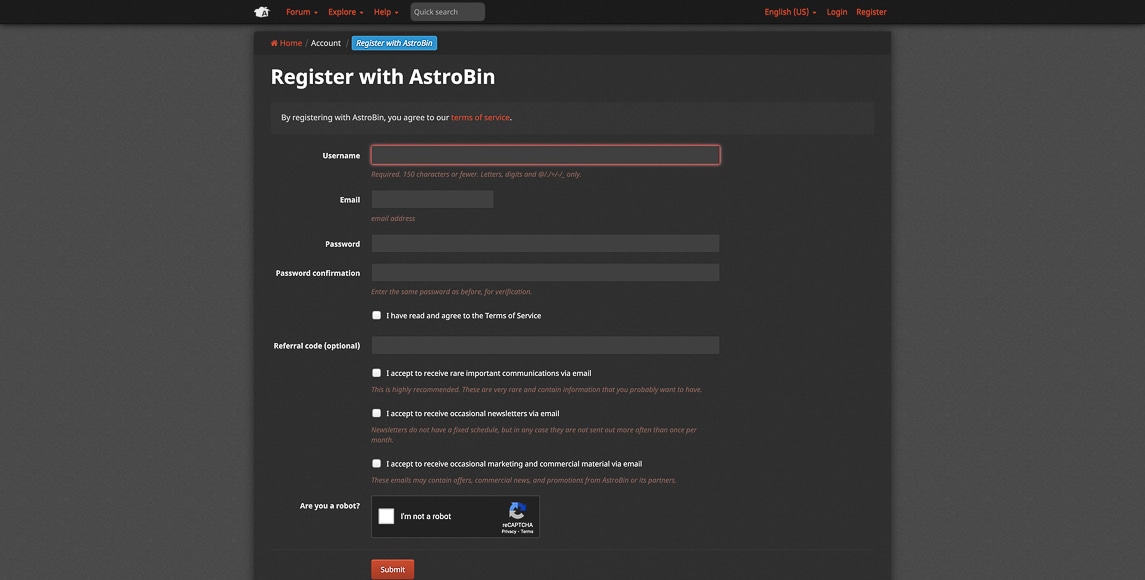
If you’re sick of incredible sights hiding 100% of their content behind pay-walls, fear not. AstroBin allows you to create a free (no-strings-attached) account to access a wide range of the site’s features.
The account registration process is easy and takes only a minute, including email confirmation.
Once you log in, the Picture of the Day greets you. Scrolling down, you have visibility of the latest forum discussions with the ability to click on any of them and instantly join the conversation.
And finally, there’s the Global Stream section that displays a feed of recently hosted images by other AstroBin users.
As we’ve covered above, you can drill down further on individual images and explore the gallery of that photographer.
Subscription Plans
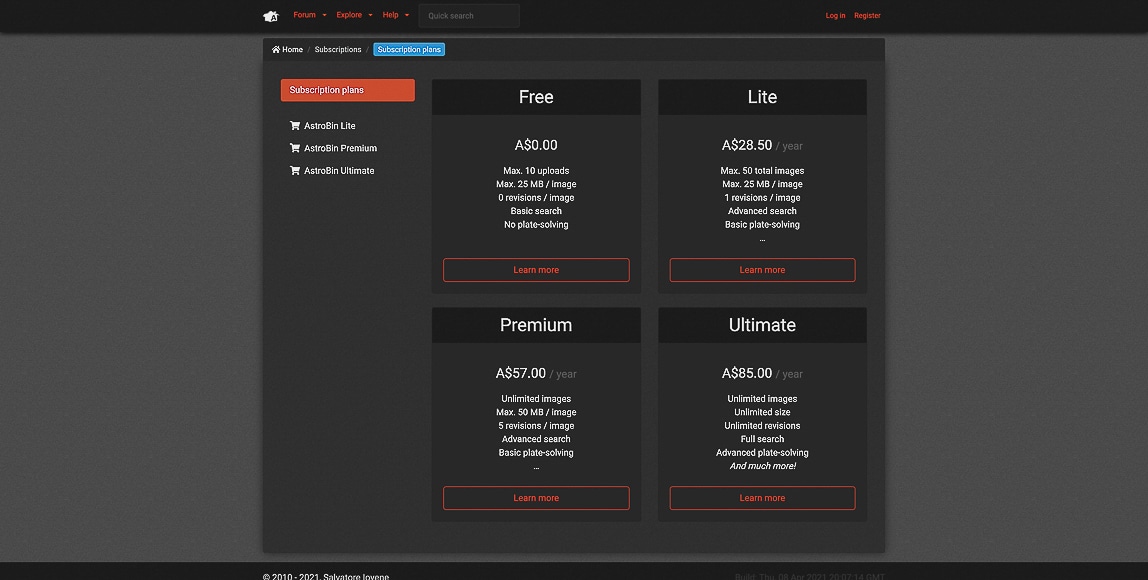
AstroBin also offers four subscription plans that are very reasonable given the services on offer. When you consider your gear’s cost and the time you invest in astrophotography, the subscription costs are small-change.
- Free Trial – the trial version of AstroBin allows you to create a page where you can host ten images with a maximum size of 25MB per image. The free trial also grants essential search functions but no plate-solving or revisions of your work.
- Astrobin Lite – The Lite plan costs $28.50 for the year with 25 image uploads at up to 25MB per image. It allows one revision per image, basic plate-solving and advanced search functionality.
- AstroBin Premium – The Premium plan costs $57.00 for the year with unlimited uploads at up to 50MB per image. It also expands to 5 revisions per image, advanced search and basic plate-solving.
- AstroBin Ultimate – The Ultimate plan lives up to its name with unlimited uploads, file sizes and revisions. Also, it provides the entire search function and advanced plate-solving. At $85, or the price of two takeaway coffees a month, you get the best of AstroBin.
Final Words

Astrophotography is such a magical and awe-inspiring genre in the photography world. So much so that it takes what we know about creating images and elevates it 1000%.
With a resource like AstroBin, you’re not just looking at a gallery of pretty pictures. You’re joining an elite field of photographers through a platform where sharing knowledge is just as necessary as sharing images.
AstroBin provides a single place for astrophotographers to share their work, learn from one another, participate in the discussion and optimise their work through available resources.
What have been your experiences with astrophotography? Do you believe that a site like AstroBin will help you elevate your astrophotography game and create stunning images?
Feel free to comment and ask questions below to become part of the conversation.
Happy shooting!

Check out these 8 essential tools to help you succeed as a professional photographer.
Includes limited-time discounts.






